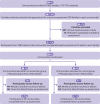Effect of home cook interventions for salt reduction in China: cluster randomised controlled trial
- PMID: 37620015
- PMCID: PMC10448250
- DOI: 10.1136/bmj-2022-074258
Effect of home cook interventions for salt reduction in China: cluster randomised controlled trial
Abstract
Objective: To determine the effects of salt reduction interventions designed for home cooks and family members.
Design: Cluster randomised controlled trial.
Setting: Six provinces in northern, central, and southern China from 15 October 2018 to 30 December 2019.
Participants: 60 communities from six provinces (10 communities from each province) were randomised; each community comprised 26 people (two people from each of 13 families).
Interventions: Participants in the intervention group received 12 month interventions, including supportive environment building for salt reduction, six education sessions on salt reduction, and salt intake monitoring by seven day weighed record of salt and salty condiments. The control group did not receive any of the interventions.
Main outcome measure: Difference between the two groups in change in salt intake measured by 24 hour urinary sodium during the 12 month follow-up.
Results: 1576 participants (775 (49.2%) men; mean age 55.8 (standard deviation 10.8) years) from 788 families (one home cook and one other adult in each family) completed the baseline assessment. After baseline assessment, 30 communities with 786 participants were allocated to the intervention group and 30 communities with 790 participants to the control group. During the trial, 157 (10%) participants were lost to follow-up, and the remaining 706 participants in the intervention group and 713 participants in the control group completed the follow-up assessment. During the 12 month follow-up, the urinary sodium excretion decreased from 4368.7 (standard deviation 1880.3) mg per 24 hours to 3977.0 (1688.8) mg per 24 hours in the intervention group and from 4418.7 (1973.7) mg per 24 hours to 4330.9 (1859.8) mg per 24 hours in the control group. Compared with the control group, adjusted mixed linear model analysis showed that the 24 hour urinary sodium excretion in the intervention group was reduced by 336.8 (95% confidence interval 127.9 to 545.7) mg per 24 hours (P=0.002); the systolic and diastolic blood pressures were reduced by 2.0 (0.4 to 3.5) (P=0.01) and 1.1 (0.1 to 2.0) mm Hg (P=0.03), respectively; and the knowledge, attitude, and behaviours in the intervention group improved significantly.
Conclusions: The community based salt reduction package targeting home cooks and family members was effective in lowering salt intake and blood pressure. This intervention has the potential to be widely applied in China and other countries where home cooking remains a major source of salt intake.
Trial registration: Chinese Clinical Trial Registry ChiCTR1800016804.
© Author(s) (or their employer(s)) 2019. Re-use permitted under CC BY. No commercial re-use. See rights and permissions. Published by BMJ.
Conflict of interest statement
Competing interests: All authors have completed the ICMJE uniform disclosure form at www.icmje.org/disclosure-of-interest/ and declare: support from the UK National Institute for Health Research for the submitted work; FJH is an unpaid member of Action on Salt and World Action on Salt, Sugar and Health (WASSH); GAM is the unpaid chairman of Blood Pressure UK and chairman of Action on Salt and Chairman of WASSH; no other relationships or activities that could appear to have influenced the submitted work.
References
Publication types
MeSH terms
Substances
LinkOut - more resources
Full Text Sources
Medical

